The Influence of Two-Region Morphology and Grain Shape on the Transport Critical Current Density in the Range from 15 K to 30 K in SiC-Doped MgB2 Wires Fabricated by the Powder-in-Tube Method
Abstract
1. Introduction
2. Materials and Methods
3. Results and Discussion
3.1. MgB2 Wire Morphology
3.2. Energy-Dispersive X-Ray Spectroscopy (EDS) Analysis
3.3. Transport Measurement
4. Conclusions
Author Contributions
Funding
Institutional Review Board Statement
Informed Consent Statement
Data Availability Statement
Conflicts of Interest
Abbreviations
| SEM | Scanning Electron Microscopy |
| TEM | Transmission Electron Microscopy |
| EDS | Energy Dispersive Spectroscopy |
| PIT | Powder-in-Tube |
| IMD | Internal Mg Diffusion |
References
- Blatter, G.; Feigelman, M.V.; Geshkenbein, V.B.; Larkin, A.I.; Vinokur, V.M. Vortices in high-temperature superconductors. Rev. Mod. Phys. 1994, 66, 1125. [Google Scholar] [CrossRef]
- Matsushita, T. Flux Pinning in Superconductors; Springer: Berlin/Heidelberg, Germany, 2007. [Google Scholar]
- Ekin, J.W. Experimental Techniques for Low-Temperature Measurements; Oxford University Press: Oxford, UK, 2006. [Google Scholar]
- Vinod, K.; Abhilash Kuma, R.G.; Syamaprasad, U. Prospects for MgB2 superconductors for magnet application. Supercond. Sci. Technol. 2007, 20, R1–R13. [Google Scholar] [CrossRef]
- Kodama, M.; Kotaki, H.; Suzuki, T.; Tanaka, H. Relation between constituent material fraction in multifilamentary MgB2 wires and requirements for MRI magnets. Supercond. Sci. Technol. 2022, 35, 094007. [Google Scholar] [CrossRef]
- Ballarino, A.; Flükiger, R. Status of MgB2 wire and cable applications in Europe. J. Phys. Conf. Ser. 2017, 871, 012098–0120105. [Google Scholar] [CrossRef]
- Yudanto, S.D.; Chandra, S.A.; Hasbi, M.Y.; Roberto, R.; Irawan, D.; Kanaya, S.; Rosoningtyas, N.; Kurniawan, B.; Susetyo, F.B.; Suhaimi, L. Structural, electrical, and mechanical properties of nano-SiC added MgB2 wire manufactured by cold working process: A comprehensive study. Appl. Phys. A 2024, 130, 831. [Google Scholar] [CrossRef]
- Birajdar, B.; Peranio, N.; Eibl, O. Quantitative electron microscopy and spectroscopy of MgB2 wires and tapes. Supercond. Sci. Technol. 2008, 21, 073001. [Google Scholar] [CrossRef]
- Yan, G.; Fu, B.Q.; Feng, Y.; Liu, C.F.; Ji, P.; Wu, X.Z.; Zhou, L.; Cao, L.Z.; Ruan, K.Q.; Li, X.G. Preparation and transport Jc(B) properties of Fe-clad MgB2 wires. Phys. C 2003, 386, 607–610. [Google Scholar] [CrossRef]
- Zhanga, W.; Zhenga, L.; Zoua, X.; Wanga, Q.; Yua, X.; Yua, Z.; Zhanga, H.; Zhao, Y.; Zhanga, Y. A novel synthesis method for MgB2 superconducting wires with kilometer-grade length. Ceram. Int. 2019, 45, 6413–6417. [Google Scholar] [CrossRef]
- Jun, B.H.; Kim, Y.J.; Tan, K.S.; Kim, J.H.; Xu, X.; Dou, S.X.; Kim, C.J. Influence of intermediate annealing on the microstructure of in situ MgB2/Fe wire. Phys. C 2008, 468, 1825–1828. [Google Scholar] [CrossRef]
- Liang, G.; Fang, H.; Hanna, M.; Yen, F.; Lv, B.; Alessandrini, M.; Keith, S.; Hoyt, C.; Tang, Z.; Salama, K. Development of Ti-sheathed MgB2 wires with high critical current density. Supercond. Sci. Technol. 2006, 19, 1146–1151. [Google Scholar] [CrossRef]
- Wang, C.; Wang, D.; Zhang, X.; Yao, C.; Wang, C.; Ma, Y.; Oguro, H.; Awaji, S.; Watanabe, K. Improved Jc–B properties of MgB2 multifilamentary wires and tapes. Supercond. Sci. Technol. 2012, 25, 125001. [Google Scholar] [CrossRef]
- Uchiyama, D.; Mizuno, K.; Akao, T.; Maeda, M.; Kawakami, T.; Kobayashi, H.; Kubota, Y.; Yasohama, K. Fibrous structure and critical current density of MgB2 superconducting wire. Cryogenics 2007, 47, 282–286. [Google Scholar] [CrossRef]
- Susner, M.A.; Daniels, T.W.; Sumption, M.D.; Rindfleisch, M.A.; Thong, C.J.; Collings, E.W. Drawing induced texture and the evolution of superconductive properties with heat treatment time in powder-in-tube in situ processed MgB2 strands. Supercond. Sci. Technol. 2012, 25, 065002. [Google Scholar] [CrossRef]
- Çiçek, Ö. Investigation of the effect of low-purity boron on the critical properties of L-IMD MgB2 wires. J. Supercond. Nov. Magn. 2025, 38, 73. [Google Scholar] [CrossRef]
- Kario, A.; Morawski, A.; Głowacki, B.A.; Łada, T.; Smaga, M.; Diduszko, R.; Kolesnikov, D.; Zaleski, A.J.; Kondrat, A.; Gajda, D. Superconducting and microstructural properties of (Mg + 2B) + MgB2/Cu wires obtained by high gas pressure technology. Acta Phys. Pol. A 2007, 111, 693–703. [Google Scholar] [CrossRef]
- Jung, A.; Schlachter, S.I.; Runtsch, B.; Ringsdorf, B.; Fillinger, H.; Orschulko, H.; Drechsler, A.; Goldacker, W. Influence of Ni and Cu contamination on the superconducting properties of MgB2 filaments. Supercond. Sci. Technol. 2010, 23, 095006. [Google Scholar] [CrossRef]
- Shcherbakova, O.V.; Pan, A.V.; Soltanian, S.; Dou, S.X.; Wexler, D. Influence of the cooling rate on the main factors affecting current-carrying ability in pure and SiC doped MgB2 superconductors. Supercond. Sci. Technol. 2007, 20, 5–10. [Google Scholar] [CrossRef]
- Qu, B.; Sun, X.D.; Li, J.G.; Xiu, Z.M.; Xue, C.P. Phase evolution and microstructure of high Jc SiC doped MgB2 fabricated by hot pressing. Supercond. Sci. Technol. 2009, 22, 075014. [Google Scholar] [CrossRef]
- Zhang, Y.; Dou, S.X.; Lu, C.; Zhou, S.H.; Li, W.X. Effect of Mg/B ration on the superconductivity of MgB2 bulk with SiC addition. Phys. Rev. B 2010, 81, 094501–094508. [Google Scholar] [CrossRef]
- Li, W.X.; Zeng, R.; Lu, L.; Li, Y.; Dou, S.X. The combined influence of connectivity and disorder on Jc and Tc performances in MgxB2+10 wt% SiC. J. Appl. Phys. 2009, 106, 093906–093913. [Google Scholar] [CrossRef]
- Shi, Z.X.; Susner, M.A.; Sumption, M.D.; Collings, E.W.; Peng, X.; Rindfleisch, M.; Tomsic, M.J. Doping effect and flux pinning mechanism of nano-SiC additions in MgB2 strands. Supercond. Sci. Technol. 2011, 24, 065015. [Google Scholar] [CrossRef]
- Yan, S.C.; Yan, G.; Lu, Y.F.; Zhou, L. The upper critical field in micro-SiC doped MgB2 fabricated by a two-step reaction method. Supercond. Sci. Technol. 2007, 20, 549–553. [Google Scholar] [CrossRef]
- Li, W.X.; Zeng, R.; Wang, J.L.; Li, Y.; Dou, S.X. Dependence of magnetoelectric properties on sintering temperature for nano-SiC-doped MgB2/Fe wires made by combined in situ/ex situ process. J. Appl. Phys. 2012, 111, 07E135. [Google Scholar] [CrossRef]
- Song, K.J.; Park, C.; Kang, S. The effect of SiC nanoparticle addition on the flux pinning properties of MgB2. Phys. C Supercond. 2010, 470, 470–474. [Google Scholar] [CrossRef]
- Wang, X.-L.; Dou, S.X.; Hossain, M.S.A.; Cheng, Z.X.; Liao, X.Z.; Ghorbani, S.R.; Yao, Q.W.; Kim, J.H.; Silver, T. Enhancement of the in-field Jc of MgB2 via SiCl doping. Phys. Rev. B 2010, 81, 224514. [Google Scholar] [CrossRef]
- Jung, S.G.; Park, S.W.; Seong, W.K.; Ranot, M.; Kang, W.N.; Zhao, Y.; Dou, S.X. A simple method for the enhancement of Jc in MgB2 thick films with an amorphous SiC impurity layer. Supercond. Sci. Technol. 2009, 22, 075010. [Google Scholar] [CrossRef]
- Dou, S.X.; Braccini, V.; Soltanian, S.; Klie, R.; Zhu, Y.; Li, S.; Wang, X.L.; Larbalestier, D. Nanoscale-SiC doping for enhancing Jc and Hc2 in superconducting MgB2. J. Appl. Phys. 2004, 96, 7549–7555. [Google Scholar] [CrossRef]
- Dou, S.X.; Horvat, J.; Soltanian, S.; Wang, X.L.; Qin, M.J.; Zhou, S.H.; Liu, H.K.; Munroe, P.G. Transport critical current density in Fe sheathed nano-SiC doped MgB2 wires. IEEE Trans. Appl. Supercond. 2003, 13, 3199–3202. [Google Scholar] [CrossRef]
- Li, W.X.; Zeng, R.; Lu, L.; Dou, S.X. Effect of thermal strain on Jc and Tc in high density nano SiC doped MgB2. J. Appl. Phys. 2011, 109, 07E108. [Google Scholar] [CrossRef]
- Flukiger, R.; Hossain, M.S.A.; Senatore, C. Strong enhancement of Jc and Birr in binary in situ MgB2 wires after cold high pressure densification. Supercond. Sci. Technol. 2009, 22, 085002. [Google Scholar] [CrossRef]
- Adamczyk, K.; Morawski, A.; Cetner, T.; Zaleski, A.; Gajda, D.; Rindfleisch, M.; Tomsic, M.; Diduszko, R.; Presz, A. Superconducting properties comparison of SiC doped multifilamentary wires of various sheaths (Cu, Monel, Glidcop) after high pressure HIP treatment. IEEE Trans. Appl. Supercond. 2012, 22, 6200204. [Google Scholar] [CrossRef]
- Li, G.Z.; Sumption, M.D.; Collings, E.W. Kinetic analysis of MgB2 layer formation in advanced internal magnesium infiltration (AIMI) processed MgB2 wires. Acta Mater. 2015, 96, 66–71. [Google Scholar] [CrossRef]
- Chen, W.; Nong, X.; Wang, Z.; Li, J.; Yang, L.; Lin, H.; Pan, X. High critical current properties of multi-filamentary MgB2 superconducting wires fabricated using an internal Mg diffusion method. Supercond. Sci. Technol. 2024, 37, 075005. [Google Scholar] [CrossRef]
- Yu, Q.; Yang, F.; Wang, Q.; Wang, Y.; Wu, B.; Yan, G.; Feng, Y.; Zhang, P. Hundred-meter-scale MgB2 multi-filament wires with Cu stabilizer fabricated by internal Mg diffusion process. Supercond. Sci. Technol. 2025, 38, 025013. [Google Scholar] [CrossRef]
- Xiong, X.; Wang, Q.; Yang, F.; Feng, J.; Li, C.; Yan, G.; Zhang, P. Improved superconducting properties of multifilament internal Mg diffusion processed MgB2 wires by rapid thermal processing. Physica C 2021, 580, 1353800. [Google Scholar] [CrossRef]
- Guanl, D.; Wang, D.; Ma, Y. Homogeneity of SiC distribution in IMD MgB2 wires. Supercond. Sci. Technol. 2021, 34, 115007. [Google Scholar]
- Yetis, H.; Avci, D.; Karaboga, F.; Gajda, D.; Akdogan, M.; Belenli, I. An innovative approach to fabricate MgB2/Fe IMD wires by magnesium powder method. Physica B 2020, 593, 412277. [Google Scholar] [CrossRef]
- Ye, S.J.; Song, M.; Matsumoto, A.; Togano, K.; Takeguchi, M.; Kumakura, H.; Teranishi, R.; Kiyoshi, T. Comparison of SiC and/or toluene additives to the critical current density of internal Mg diffusion-processed MgB2 wires. Physica C 2013, 484, 167–170. [Google Scholar] [CrossRef]
- Gajda, D.; Babij, M.; Zaleski, A.; Avci, D.; Karaboga, F.; Yetis, H.; Belenli, I.; Zasada, D.; Szymański, D.; Małecka, M.; et al. The influence of Sm2O3 dopant on structure, morphology and transport critical current density of MgB2 wires investigated by using the transmission electron microscope. J. Magnes. Alloys 2024, 12, 5061–5078. [Google Scholar] [CrossRef]
- Pelissier, J.L. Determination of the phase diagram of magnesium: A model-potential approach in the sub-megabar range. Phys. Scr. 1986, 34, 838–842. [Google Scholar] [CrossRef]
- Kennedy, G.C.; Newton, R.C. Solids Under Pressure; Paul, W., Warschauer, D.M., Eds.; McGrraw-Hill Book Company: New York, NY, USA, 1963; p. 163. [Google Scholar]
- Kim, J.H.; Heo, Y.U.; Matsumoto, A.; Kumakura, H.; Rindfeisch, M.; Tomsic, M.; Dou, S.X. Comparative study of mono-and multi-filament MgB2 wires with different boron powders and malic acid addition. Supercond. Sci. Technol. 2010, 23, 075014. [Google Scholar] [CrossRef]
- Nagamatsu, J.; Nakagawa, N.; Muranaka, T.; Zenitany, I.; Akimitsu, J. Superconductivity at 39 K in magnesium diboride. Nature 2001, 410, 63–66. [Google Scholar] [CrossRef]
- Susner, M.A.; Sumption, M.D.; Bhatia, M.; Peng, X.; Tomsic, M.J.; Rindfleisch, M.R.; Collings, E.W. Influence of Mg/B ratio and SiC doping on microstructure and high field transport Jc in MgB2 strands. Physica C 2007, 456, 180–187. [Google Scholar] [CrossRef]
- Kazakov, S.M.; Puzniak, R.; Rogacki, K.; Mironov, A.V.; Zhigadlo, N.D.; Jun, J.; Soltmann, C.; Batlogg, G.; Karpinski, J. Carbon substitution in MgB2 single crystals: Structural and superconducting properties. Phys. Rev. B 2005, 71, 024533. [Google Scholar] [CrossRef]
- Dew-Hughes, D. Flux pinning mechanisms in type II superconductors. Philos. Mag. 1974, 30, 293–305. [Google Scholar] [CrossRef]
- Gajda, D.; Zaleski, A.J.; Morawski, A.J.; Babij, M.; Szymański, D.; Gajda, G.; Rindfleisch, M.A.; Shahbazi, M.; Hossain, M.S.A. Superior engineering critical current density obtained via hot isostatic pressing of MgB2 wires manufactured using nano-amorphous isotopic boron. J. Alloys Compd. 2021, 871, 159579. [Google Scholar] [CrossRef]
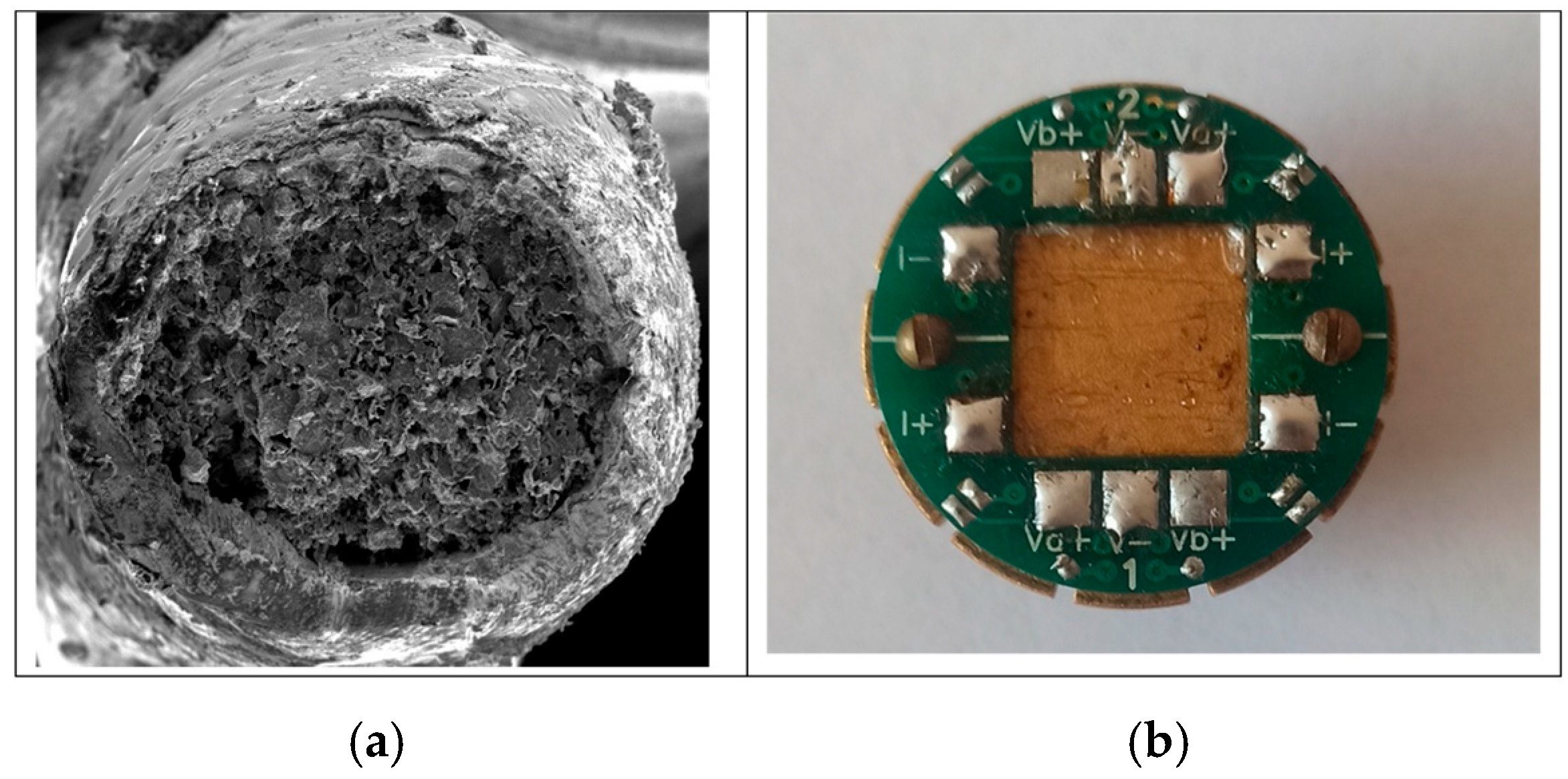

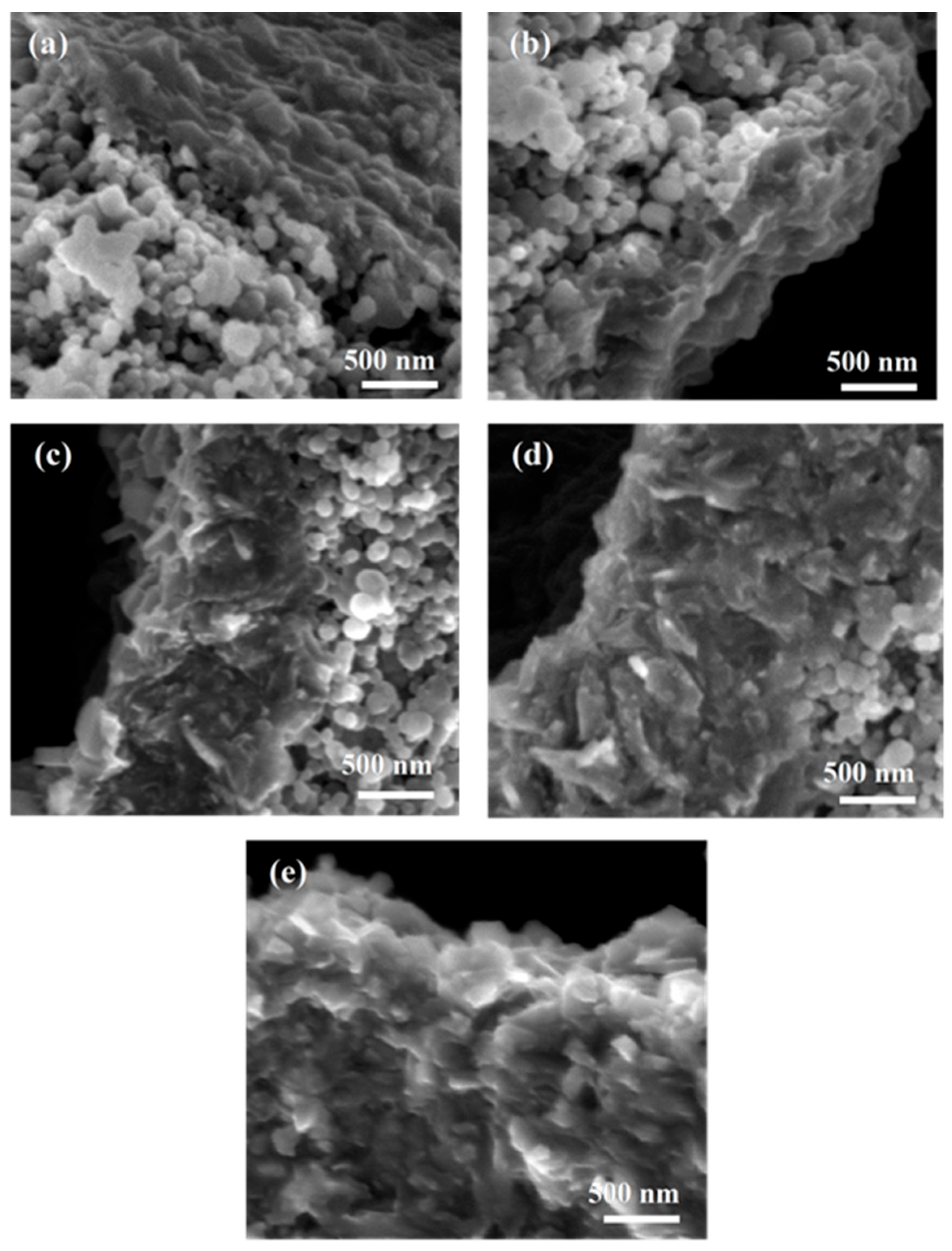

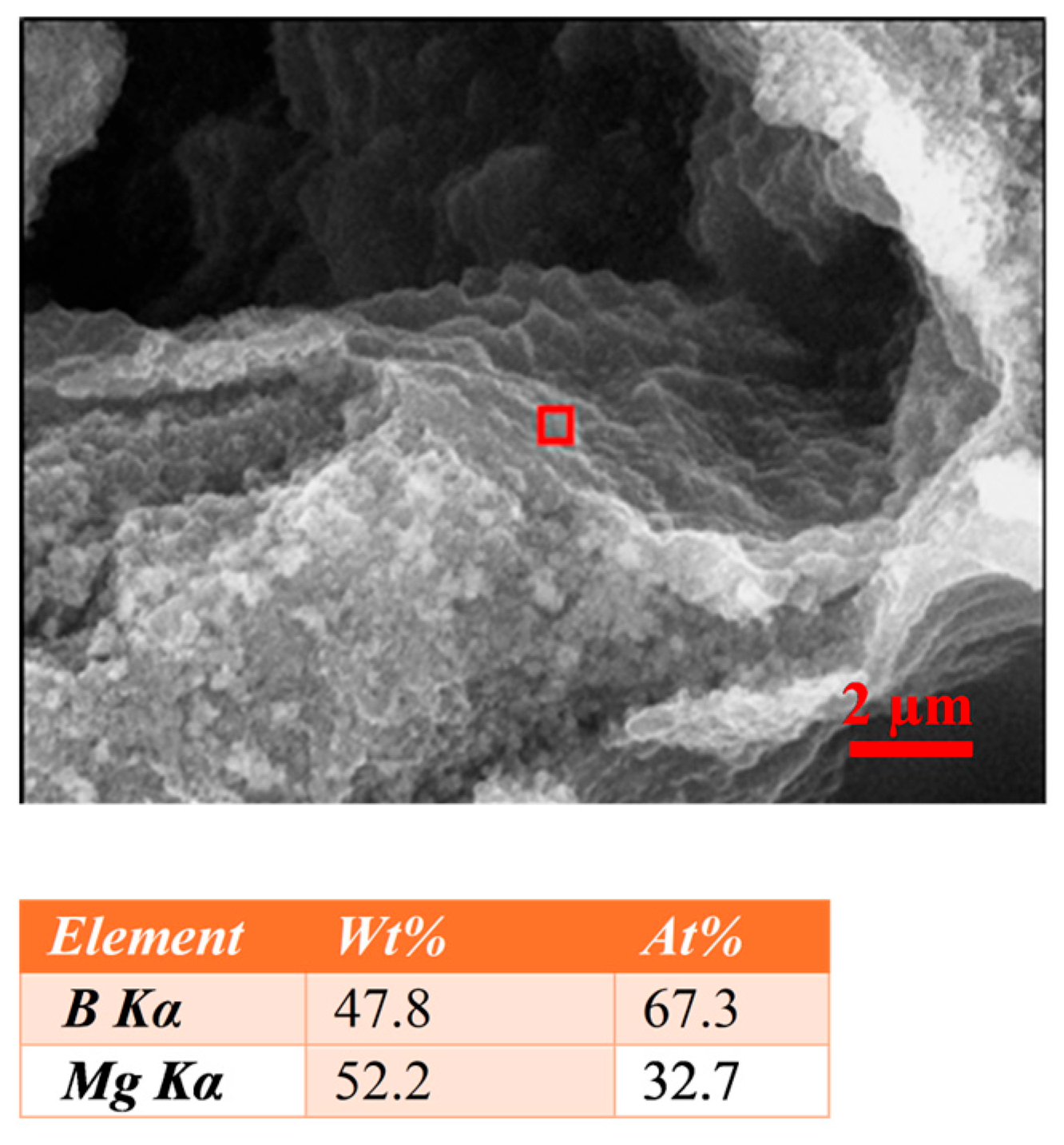

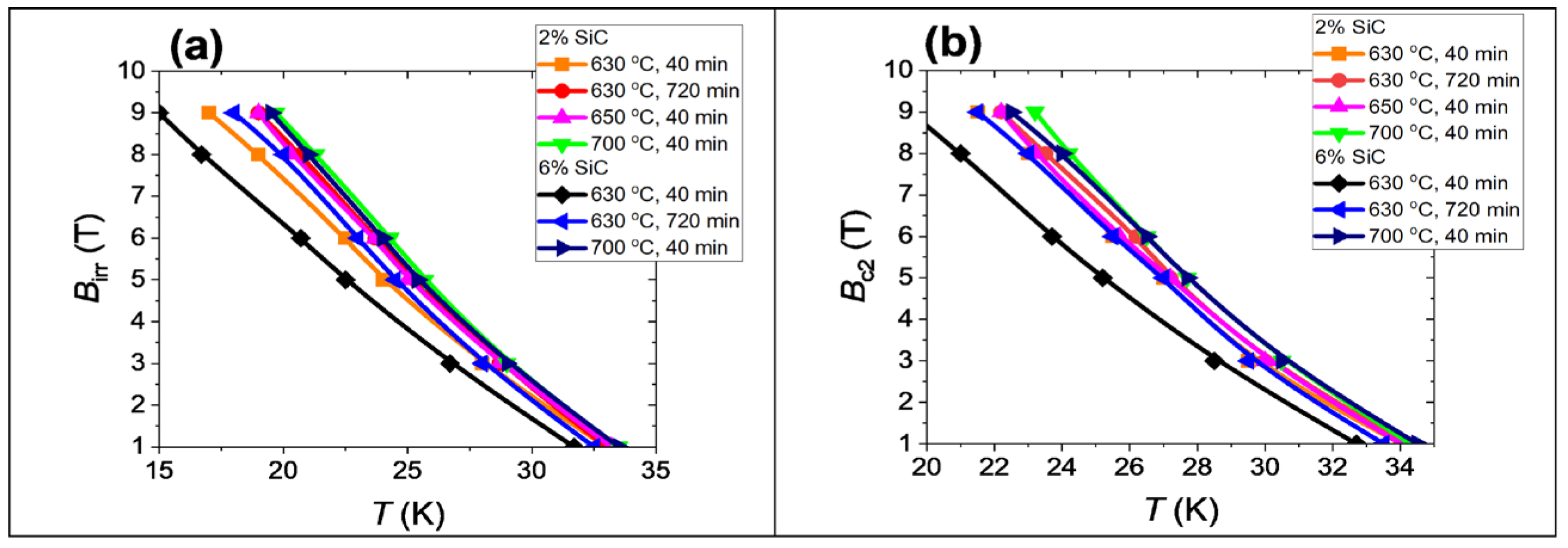
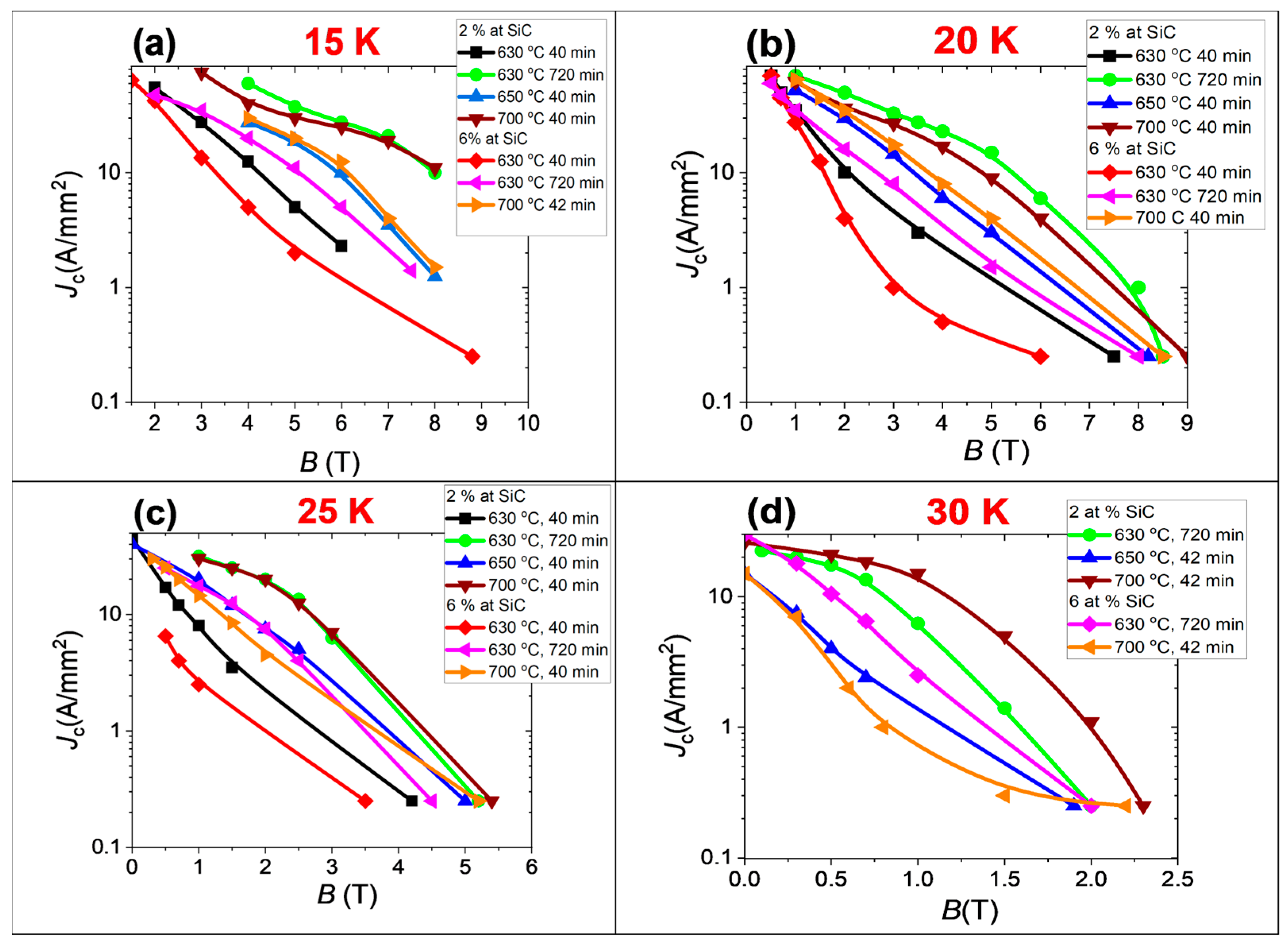

| Sample No | Heating Temperature [°C] | Heating Time [Minutes] | The Amount of Admixture [at. %] | Tc for B = 0 T [K] |
|---|---|---|---|---|
| A | 630 | 40 | 2 | 36 |
| B | 630 | 720 | 2 | 36 |
| C | 650 | 40 | 2 | 36 |
| D | 700 | 40 | 2 | 36 |
| E | 630 | 40 | 6 | 34.5 |
| F | 630 | 720 | 6 | 35.3 |
| G | 700 | 40 | 6 | 36 |
Disclaimer/Publisher’s Note: The statements, opinions and data contained in all publications are solely those of the individual author(s) and contributor(s) and not of MDPI and/or the editor(s). MDPI and/or the editor(s) disclaim responsibility for any injury to people or property resulting from any ideas, methods, instructions or products referred to in the content. |
© 2025 by the authors. Licensee MDPI, Basel, Switzerland. This article is an open access article distributed under the terms and conditions of the Creative Commons Attribution (CC BY) license (https://creativecommons.org/licenses/by/4.0/).
Share and Cite
Gajda, D.; Babij, M.; Zaleski, A.; Avci, D.; Yetis, H.; Belenli, I.; Karaboga, F.; Szymanski, D.; Czujko, T. The Influence of Two-Region Morphology and Grain Shape on the Transport Critical Current Density in the Range from 15 K to 30 K in SiC-Doped MgB2 Wires Fabricated by the Powder-in-Tube Method. Materials 2025, 18, 3960. https://doi.org/10.3390/ma18173960
Gajda D, Babij M, Zaleski A, Avci D, Yetis H, Belenli I, Karaboga F, Szymanski D, Czujko T. The Influence of Two-Region Morphology and Grain Shape on the Transport Critical Current Density in the Range from 15 K to 30 K in SiC-Doped MgB2 Wires Fabricated by the Powder-in-Tube Method. Materials. 2025; 18(17):3960. https://doi.org/10.3390/ma18173960
Chicago/Turabian StyleGajda, Daniel, Michał Babij, Andrzej Zaleski, Dogan Avci, Hakan Yetis, Ibrahim Belenli, Fırat Karaboga, Damian Szymanski, and Tomasz Czujko. 2025. "The Influence of Two-Region Morphology and Grain Shape on the Transport Critical Current Density in the Range from 15 K to 30 K in SiC-Doped MgB2 Wires Fabricated by the Powder-in-Tube Method" Materials 18, no. 17: 3960. https://doi.org/10.3390/ma18173960
APA StyleGajda, D., Babij, M., Zaleski, A., Avci, D., Yetis, H., Belenli, I., Karaboga, F., Szymanski, D., & Czujko, T. (2025). The Influence of Two-Region Morphology and Grain Shape on the Transport Critical Current Density in the Range from 15 K to 30 K in SiC-Doped MgB2 Wires Fabricated by the Powder-in-Tube Method. Materials, 18(17), 3960. https://doi.org/10.3390/ma18173960








